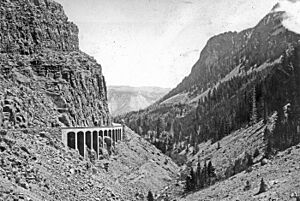List of mountain passes in Wyoming (K–Y) facts for kids
Wyoming is a state in the western part of the United States, famous for its amazing mountains. Because of all these mountains, Wyoming has at least 250 named mountain passes! A mountain pass is like a natural pathway or a lower point between two mountains or hills. These passes make it easier for people, animals, and even roads to travel through tough mountain areas.
Wyoming is the 10th largest state in the U.S. by land area, but it has the fewest people. This means there's lots of open space! The western two-thirds of the state is covered by parts of the Rocky Mountains and wide-open rangelands. The eastern third is a high, flat area called the High Plains. This mix of tall mountains and high plains is why Wyoming has so many different kinds of passes.
Contents
Exploring Wyoming's Mountain Passes
Mountain passes in Wyoming can be found in many different counties and at various heights. Some passes are very high up in the mountains, while others are lower "gaps" or "cuts" in the landscape. Each pass has its own unique story and features.
What is a Mountain Pass?
Imagine you're trying to get from one side of a big mountain range to the other. Instead of climbing straight over the tallest peaks, you'd look for the lowest point or a natural valley that cuts through the mountains. That's a mountain pass! They are important routes for travel and trade, and they have been used for thousands of years by Native Americans, explorers, and pioneers.
How High Are Wyoming's Passes?
The height of a mountain pass is called its elevation. In Wyoming, passes can range from relatively low to very high. For example, Seward Pass in Platte County is about 4,734 feet (1,443 meters) high. On the other hand, Stone Pillar Pass in Sublette County is much higher, reaching about 12,277 feet (3,742 meters)! This shows how varied the landscape of Wyoming is.
Famous and Important Passes
Many passes in Wyoming have played a big role in history. For example, South Pass in Fremont County was a very important route for pioneers traveling west on the Oregon Trail and California Trail. It was a wide, gentle slope that allowed wagons to cross the Continental Divide without too much difficulty.
Other passes are known for their stunning views or for being part of popular hiking trails.
- Teton Pass in Teton County is a well-known pass that connects Jackson Hole, Wyoming, with Victor, Idaho. It's a beautiful drive with amazing scenery.
- Togwotee Pass in Teton County is another high pass that offers incredible views of the Teton Range and is popular for winter sports like snowmobiling.
- Powder River Pass in Johnson County is a high mountain pass in the Bighorn Mountains, known for its scenic beauty.
Why So Many Passes?
Wyoming's geography is the main reason it has so many passes. The state is home to several major mountain ranges, including the Rocky Mountains, the Bighorn Mountains, the Absaroka Range, and the Teton Range. These mountains create natural barriers, and over millions of years, forces like water, ice, and wind have carved out the lower points and valleys that we now call passes or gaps.
These passes are not just important for travel; they also influence weather patterns and create unique habitats for plants and animals. They are a key part of Wyoming's rugged and beautiful landscape.
Images for kids
See also
- List of mountain passes in Wyoming (A–J)



